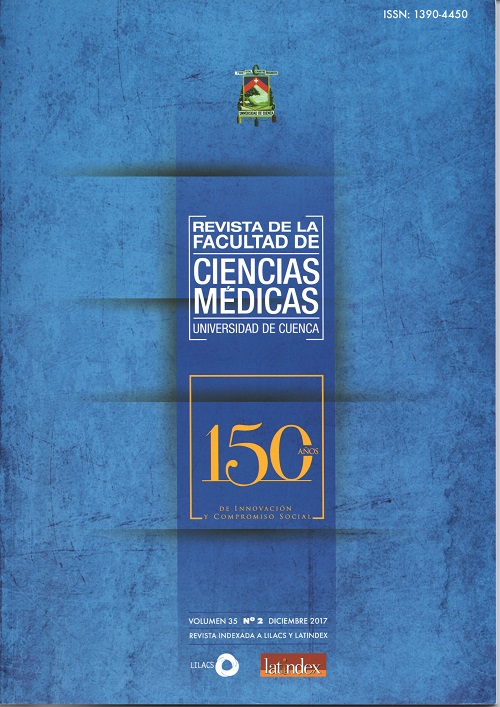Factores fetales asociados a retardo del crecimiento intrauterino (RCIU) en hijos de adolescentes. Hospital Vicente Corral, Cuenca-Ecuador, 2013
Resumen
RESUMEN
Introducción: Los factores que intervienen en la vida intrauterina tienen repercusiones en la vida embrionaria y fetal, en torno al nacimiento y en la vida futura del individuo.
Objetivo: Determinar los factores fetales asociadas a RCIU en hijos de adolescentes nacidos en el Hospital Vicente Corral de Cuenca-Ecuador, durante el 2013.
Material y métodos: Diseño de casos y controles; población: recién nacidos (RN) hijos de adolescentes nacidos en el Hospital Vicente Corral, en Cuenca-Ecuador, 2013; muestra: no probabilística, casos: 116 RN con RCIU hijos de adolescentes, controles: 348 RN sin RCIU hijos de adolescentes.
Resultados: El RCIU se presentó con mayor frecuencia en RN del sexo femenino (53.4%), el tipo de RCIU predominante fue asimétrico (57.8%). Las medidas antropométricas neonatales peso (p=0.001), talla (p=0.001) y perímetro cefálico (p=0.001) presentaron asociación estadística al RCIU. De acuerdo al análisis binario, los factores fetales asociados a RCIU fueron: prematuridad (OR=2.70, IC 95%=1.17-6.20, p=0.016) y gemelaridad (OR=18.93, IC=95% 2.25-158.93, p=0.001); los factores fetales sin asociación a RCIU fueron: sexo, infecciones TORCH, malformaciones congénitas mayores (p>0.05). Según regresión logística binaria, la gemelaridad fue la única asociada al RCIU (Exp B=16.36, IC 95%=1.92-139.64, p=0.011).
Conclusiones: El RCIU se presentó con mayor frecuencia en el sexo femenino, predominó el de tipo asimétrico. Peso, talla y perímetro cefálico neonatal estuvieron asociadas a RCIU. Los factores fetales asociados a RCIU según análisis binario fueron: prematuridad y gemelaridad, y por regresión logística binaria: gemelaridad.
Palabras clave: Retardo del crecimiento fetal, factores de riesgo,adolescente, recién nacido.
ABSTRACT
Introduction: The factors involve in the intrauterine life have repercussions in the embryonic and fetal life, around the birth, and in the future life of the individual.
Objective: To determine the fetal factors associated with IUGR in teenager´s children who born in the Vicente Corral Hospital in Cuenca-Ecuador during 2013.
Material and methods: Case-control design; universe: newborn (NB) teens´ children born at Vicente Corral Hospital, Cuenca-Ecuador, 2013; sample: not random, cases: 116 NB with IUGR teenagers´ children, controls: 348 NB teenager´s children without IUGR.
Results: The IUGR was presented more frequently in female RN (53.4%), the predominant IUGR type was asymmetrical (57.8%). The neonatal anthropometric measurements weight (p = 0.001), height (p = 0.001) and cephalic perimeter (p = 0.001) presented statistical association to the IUGR. According to the binary analysis, the fetal factors associated with IUGR were: prematurity (OR = 2.70, 95% CI = 1.17-6.20, p = 0.016) and twinness (OR = 18.93, CI = 95% 2.25-158.93, p = 0.001); fetal factors not associated with IUGR were: sex, TORCH infections, major congenital malformations (p> 0.05). According to binary logistic regression, twinness was the only one associated with IUGR (Exp B =16.36, 95% CI = 1.92-139.64, p = 0.011).
Conclusions: The IUGR was presented more frequently in the female sex, predominantly the asymmetric type. Neonatal weight, size and cephalic perimeter were associated to IUGR. The fetal factors associated to IUGR according to binary analysis were: prematurity and twinness, and binary logistic regression: twinness.
Keywords: Fetal Growth Retardation, risk factors, adolescent, Infant, Newborn, hospitals.
Descargas
Descargas
Publicado
Número
Sección
Licencia
Copyright © Autors

Usted es libre de:
 |
Compartir — compartir y redistribuir el material publicado en cualquier medio o formato. |
 |
Adaptar — combinar, transformar y construir sobre el material para cualquier propósito, incluso comercialmente. |
Bajo las siguientes condiciones:
 |
Atribución — Debe otorgar el crédito correspondiente, proporcionar un enlace a la licencia e indicar si se realizaron cambios. Puede hacerlo de cualquier manera razonable, pero de ninguna manera que sugiera que el licenciador lo respalda a usted o a su uso. |
| No comercial — No puede utilizar el material con fines comerciales. | |
| Compartir Igual— si remezcla, transforma o desarrolla el material, debe distribuir sus contribuciones bajo la misma licencia que el original. |
| Sin restricciones adicionales: no puede aplicar términos legales o medidas tecnológicas que restrinjan legalmente a otros a hacer cualquier cosa que permita la licencia. |






